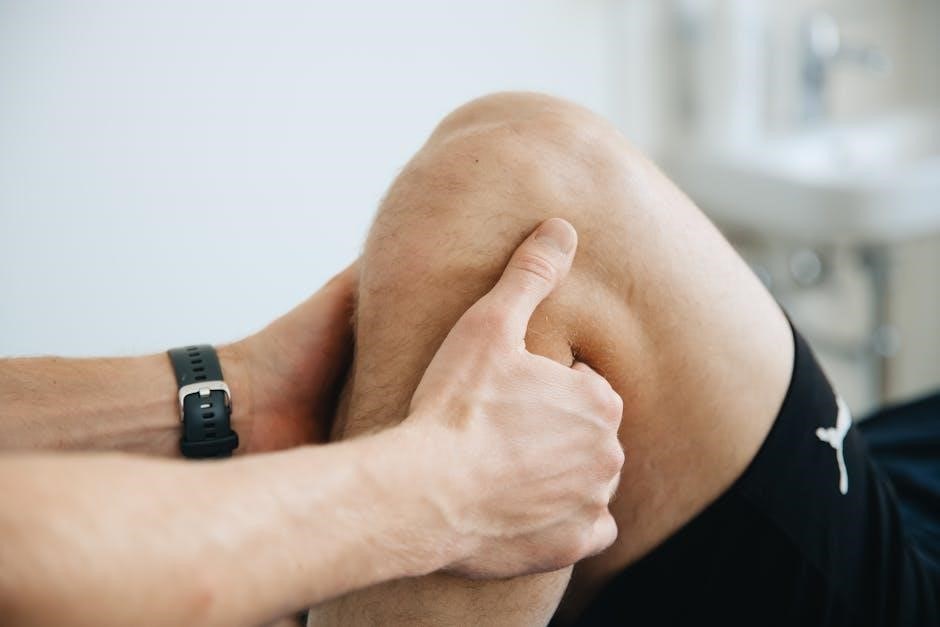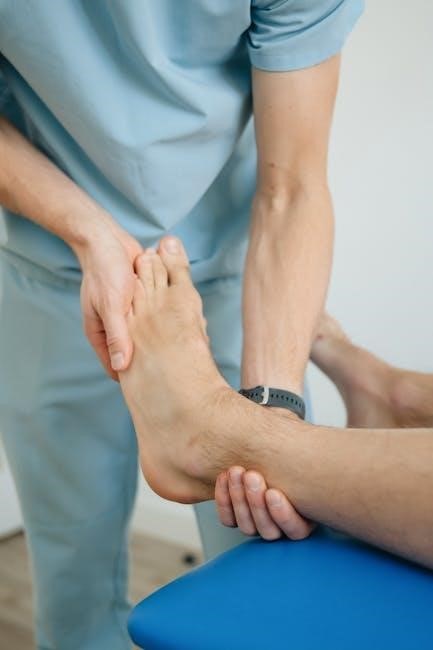The sacroiliac (SI) joint connects the sacrum and ilium‚ playing a crucial role in pelvic stability and movement. Stabilization exercises target this joint to enhance strength‚ reduce pain‚ and improve mobility‚ often recommended by physical therapists to address SI joint dysfunction and promote overall lower back health.
1.1 What is the Sacroiliac Joint?
The sacroiliac (SI) joint is an irregularly shaped joint connecting the sacrum (base of the spine) to the ilium (pelvic bone). It plays a vital role in pelvic stability and movement‚ allowing activities like walking and bending. The joint is supported by strong ligaments‚ but factors like trauma‚ posture‚ or repetitive stress can lead to instability or pain. Understanding its structure and function is key to addressing SI joint-related issues and developing effective stabilization exercises.
1.2 Importance of SI Joint Stability
SI joint stability is crucial for maintaining proper pelvic alignment and preventing dysfunction. Instability in the SI joint can lead to pain‚ limited mobility‚ and discomfort during daily activities. Strengthening the surrounding muscles and ligaments helps improve joint stability‚ reducing the risk of injury and enhancing overall lower back health. A stable SI joint supports efficient movement and distributes forces evenly‚ minimizing wear and tear on the joint and surrounding structures.

Strengthening Exercises for SI Joint Stabilization
Strengthening exercises target muscles around the SI joint to improve stability‚ reduce pain‚ and enhance lower back health. These exercises promote proper movement and joint function.
2.1 Pelvic Tilt Exercise
The pelvic tilt is a fundamental exercise for SI joint stabilization. Lie on your back‚ knees bent‚ and feet flat on the floor. Engage your core‚ flatten your lower back against the ground‚ and tilt your pelvis upwards. Hold for 6-10 seconds‚ then release. Repeat 8-12 times. This movement strengthens abdominal muscles and improves pelvic alignment‚ providing stability to the SI joint and reducing discomfort.
2.2 Bird Dog Exercise
The Bird Dog Exercise enhances core stability and SI joint alignment. Start on your hands and knees. Extend one arm forward and the opposite leg backward‚ keeping them straight. Hold for 6-10 seconds‚ then return to the starting position. Repeat 8-12 times on each side. This exercise improves balance‚ strengthens pelvic muscles‚ and promotes proper SI joint movement‚ reducing instability and discomfort effectively. Progress by increasing hold duration as strength improves.

Stretching Exercises for SI Joint Mobility
Stretching exercises improve SI joint flexibility and reduce stiffness. Gentle movements target surrounding muscles‚ enhancing joint mobility and alleviating discomfort. Regular stretching promotes better alignment and stability.
3.1 Cat-Cow Stretch
The Cat-Cow Stretch gently mobilizes the sacroiliac joint‚ improving flexibility and relieving tension. Begin on hands and knees‚ inhaling as you arch your back (Cow Pose) and exhaling as you round your spine (Cat Pose). Repeat 10-15 times‚ maintaining slow‚ controlled movements. This exercise enhances spinal mobility and reduces stiffness in the SI joint area‚ promoting better posture and comfort during daily activities. Consistency is key for optimal results.
3.2 Knee to Chest Stretch
Lie on your back and bring one knee toward your chest‚ holding onto your knee with your hand. Gently pull your knee toward your chest until you feel a stretch in your lower back and hip. Hold for 20-30 seconds‚ then slowly lower your leg. Repeat on the other side. This stretch helps relieve tension in the SI joint and improves hip flexibility. Perform 2-3 repetitions on each side for optimal benefits.
Stabilization Techniques and Tools
Stabilization techniques focus on strengthening core muscles and improving pelvic alignment. Tools like SI belts provide additional support‚ enhancing joint stability and reducing discomfort during exercises.
4.1 Plank Exercise for Core Stability
The plank exercise is a fundamental stabilization technique that strengthens the core muscles‚ including the abdominals and lower back. By maintaining a straight line from head to heels‚ it enhances pelvic stability and supports the SI joint. Hold the position for 10-30 seconds‚ gradually increasing duration as strength improves. Proper form is essential to avoid strain and maximize benefits for SI joint stability.
4.2 Bridging Exercise for Pelvic Stability
The bridging exercise strengthens the muscles around the pelvis and lower back‚ enhancing SI joint stability. Lie on your back with knees bent and feet flat. Slowly lift your pelvis‚ squeezing your abdominal muscles to support the movement. Hold for a few seconds‚ then lower gently. Perform 8-12 repetitions‚ focusing on controlled movements to avoid strain. This exercise helps improve pelvic alignment and reduces SI joint instability by targeting key stabilizing muscles.
Creating a Daily Workout Plan
A well-structured daily workout plan should include a mix of strengthening and stretching exercises‚ focusing on core and pelvic stability. Start with gentle warm-ups‚ incorporate key exercises like pelvic tilts and bird dogs‚ and finish with stretching to improve mobility. Aim for consistency and gradually increase intensity as strength improves.
5.1 Sample Exercise Routine
Begin with a 5-10 minute warm-up‚ such as light walking or gentle stretching. Perform the Pelvic Tilt (3 sets of 12-15 repetitions) to engage core muscles. Follow with the Bird Dog Exercise (3 sets of 8-12 reps per side) to improve balance and stability. Incorporate the Cat-Cow Stretch (10-15 repetitions) for mobility. End with the Bridging Exercise (3 sets of 10-15 reps) to strengthen pelvic muscles. Rest for 30-60 seconds between sets and adjust intensity based on comfort.
5.2 Tips for Consistency and Progression
Start with short‚ manageable sessions (10-15 minutes) and gradually increase duration as comfort allows. Track progress weekly to monitor improvements and adjust exercises accordingly. Focus on proper form to avoid injury and enhance effectiveness. Incorporate variations of exercises to keep the routine engaging and prevent plateaus. Rest for 48 hours between intense workouts to allow muscle recovery. Use an SI belt for additional support during exercises if needed. Stay hydrated and maintain a balanced diet to support muscle health and recovery.

Using an SI Belt for Additional Support
An SI belt provides external compression to stabilize the sacroiliac joint‚ enhancing pelvic alignment and reducing discomfort during exercises or daily activities‚ offering additional support and stability.
6.1 How an SI Belt Works
An SI belt works by applying gentle‚ consistent compression to the sacroiliac joints‚ stabilizing the pelvis and improving joint alignment. This compression helps reduce excessive movement in the SI joint‚ which can cause pain and instability. The belt is typically worn around the natural waistline‚ just above the hip bones‚ and is designed to provide additional support during exercises‚ daily activities‚ or recovery. It enhances proprioception‚ helping the body maintain better posture and pelvic stability without restricting natural movement.
6.2 When to Use an SI Belt
An SI belt is commonly used during exercises‚ daily activities‚ or recovery to provide additional support and stability to the sacroiliac joints. It is particularly beneficial for individuals experiencing SI joint pain‚ instability‚ or dysfunction. The belt can be worn during physical therapy‚ after injuries‚ or to alleviate discomfort during activities that strain the pelvis. It is also recommended for post-pregnancy recovery or for those with chronic SI joint issues to help maintain proper alignment and reduce pain.
Common Mistakes to Avoid in SI Joint Exercises
Common mistakes include overexertion‚ ignoring pain‚ and improper form. Avoid bouncing or forcing movements‚ as this can worsen joint instability. Always prioritize gentle‚ controlled motions.
7.1 Overexertion and Pain
Overexertion during SI joint exercises can lead to increased pain and instability. It’s crucial to recognize when pain arises and stop the exercise immediately. Continuing despite discomfort may exacerbate the condition. Gentle‚ controlled movements are essential to avoid aggravating the joint. Always prioritize pain-free ranges of motion and gradually progress exercises to build strength without risking further injury or inflammation.
7.2 Improper Form and Technique
Improper form and technique during SI joint stabilization exercises can lead to ineffective results or even injury. Common mistakes include arching the back‚ lifting the pelvis too high‚ or failing to engage core muscles. Poor alignment can strain the SI joint or surrounding muscles‚ worsening instability. It’s essential to follow precise instructions and maintain controlled movements. Consulting a physical therapist can help correct technique and ensure exercises are performed safely and effectively to promote proper joint stabilization.

Role of Physical Therapy in SI Joint Stabilization
Physical therapy plays a key role in SI joint stabilization by providing personalized exercise programs‚ correcting improper techniques‚ and enhancing joint mobility through guided‚ evidence-based practices.
8.1 When to Consult a Physical Therapist
Consult a physical therapist if SI joint pain persists‚ worsens‚ or limits daily activities. They can provide a personalized approach to address instability‚ offering tailored exercises and therapies to restore function and reduce discomfort. Seeking professional guidance ensures proper technique and progression‚ preventing further injury and promoting effective recovery. Early intervention can significantly improve outcomes for those with SI joint-related issues.
8.2 Customized Exercise Programs
A physical therapist creates tailored exercise plans based on individual needs‚ focusing on SI joint stability and strength. These programs often include specific stretches‚ strengthening exercises‚ and mobility work. The therapist assesses the patient’s condition‚ sets realistic goals‚ and monitors progress. Customized plans ensure exercises are safe‚ effective‚ and aligned with the patient’s lifestyle‚ promoting optimal recovery and long-term joint health. Regular adjustments are made to reflect improvements and address remaining challenges.
When to Seek Medical Advice
Consult a healthcare provider if experiencing severe SI joint instability‚ persistent pain‚ or limited mobility. Professional diagnosis and treatment are crucial for effective management and recovery.
9.1 Signs of Severe SI Joint Instability
Severe SI joint instability may manifest as persistent‚ sharp pain in the lower back or buttocks‚ difficulty walking‚ or a noticeable limp. You might experience a feeling of pelvic instability or “giving way‚” making it hard to stand or sit comfortably. Swelling or bruising near the joint area could also occur. These symptoms significantly impact daily activities‚ necessitating prompt medical evaluation to rule out serious underlying issues and ensure proper treatment.
9.2 Diagnostic Tests and Treatments
Diagnosing SI joint instability often involves physical exams‚ imaging (e.g.‚ X-rays or MRIs)‚ and sometimes injections to confirm the source of pain. Treatments vary‚ with physical therapy and anti-inflammatory medications being common first steps. In severe cases‚ minimally invasive procedures or surgery may be necessary to stabilize the joint. Non-surgical options are typically prioritized unless instability is resistant to conservative measures.

